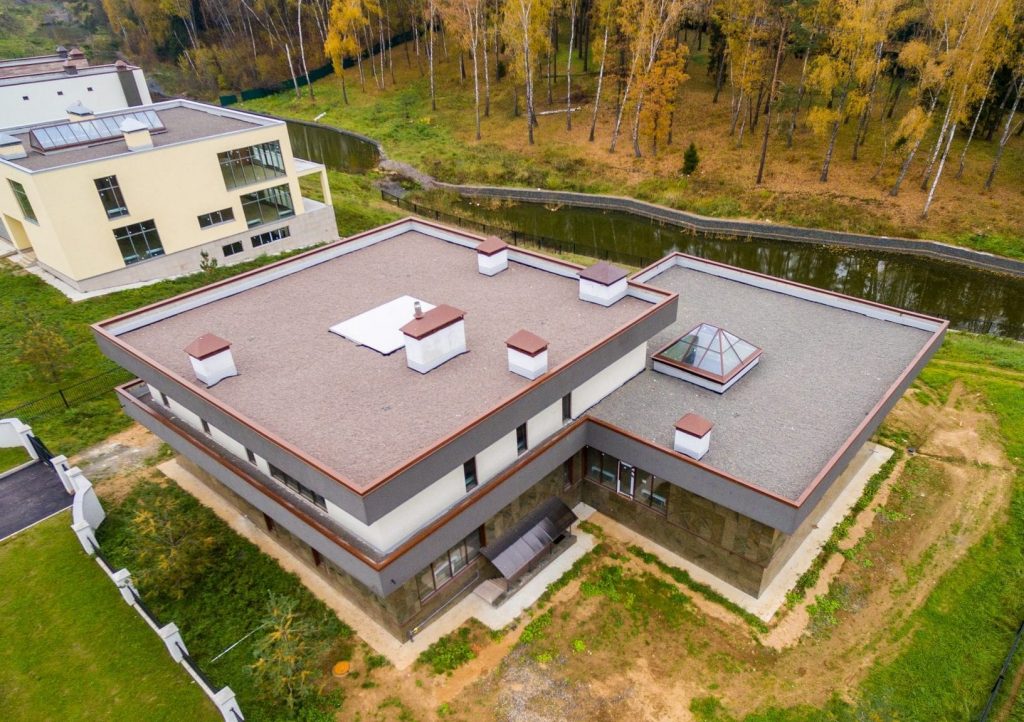
Flat roofs are very economical. A reinforced concrete slab covered with roofing material is much simpler than the design of a pitched roof during installation, maintenance, and repair. And why then in private cottages so seldom do a flat roof? Let’s deal with this issue.
Features of a flat roof
Apparently, one of the main features of a flat roof is a bright affiliation to the style of high-tech. This immediately limits its use in cottages of classical, peasant-style, or log cabins made in the style of a chalet.
Also, flat roofs are further divided into four types:
Roof for use. For its construction solid materials are used – concrete, expanded clay, cement. Such a roof is actively used and subjected to constant stress. Here you can arrange recreation areas, such a roof can replace a gazebo in the garden, on such a roof you can even make a pool.
Unused roof. It does not have a rigid base for laying waterproofing material or insulation due to the lack of such a need. Such a roof is cheap to build, but not durable in operation, compared with the used roof.
A traditional type of flat roof. It differs in that the waterproofing layer is above the thermal insulation layer. All layers of materials are laid on reinforced concrete floors.
Inversion roof. Has a significant difference from others. Here, the waterproofing layer is placed under the thermal insulation material. This feature protects the waterproofing layer from the effects of sun, frost, and precipitation. This significantly extends its service life and protects the roof from leaks. On such a roof you can create a lawn or put soft tiles.
Advantages of a flat roof:
- Choosing a flat roof for the house allows you to save well on building materials. After all, the construction of a pitched roof requires many more elements, and it is necessary to install a rafter system, make a lattice. When building a flat roof, all these costs are completely offset.
- The construction of a pitched roof is much more difficult and dangerous, because the work is carried out at an angle, and in such conditions, it is difficult to maintain balance. Building a flat roof is safer and faster.
- Quite specific replacement and repair of damaged areas on the pitched roof can be carried out only by professional roofers, and improperly performed work can lead to leakage of the roof. Repair of a flat roof and replacement of damaged areas is done quickly and safely, it is easy to do yourself to the owner of the building.
- More space. On a flat roof, it is convenient to install the necessary equipment: antennas, air conditioners, solar panels are increasingly being installed on roofs. Installation of such equipment on a pitched roof is very difficult and requires additional fastening.
- Possibility to arrange a green roof. You can make a seating area on a flat roof. Green grass under your feet, a set of rattan furniture, and a beautiful landscape will help you relax and enjoy your holiday. Now on flat roofs arrange real greenhouses and even plant a garden.
- Opportunity to continue construction. If you want to expand your living space, you can easily complete a new floor with a flat roof in the house. It will be much harder to do this on a sloping roof, as you will first have to completely disassemble it.
Disadvantages of flat roofs:
- The main disadvantage of using a flat roof is the accumulation of snow and debris on it. Large accumulations of snow can cause damage and leaking of the roof. Therefore, it is still recommended to follow a small slope for drainage of precipitation, with a minimum angle of 2°.
- Periodically it is necessary to manually clean the roof from debris and precipitation, as they will no longer go down on their own, as on a pitched roof.
- When building a flat roof, you need to think carefully about the gutter system, which will also need to be cleaned of debris, and also, there is a risk of freezing.
- It is necessary to constantly check the integrity and tightness of the roofing.
Picture Credit: Freepik
